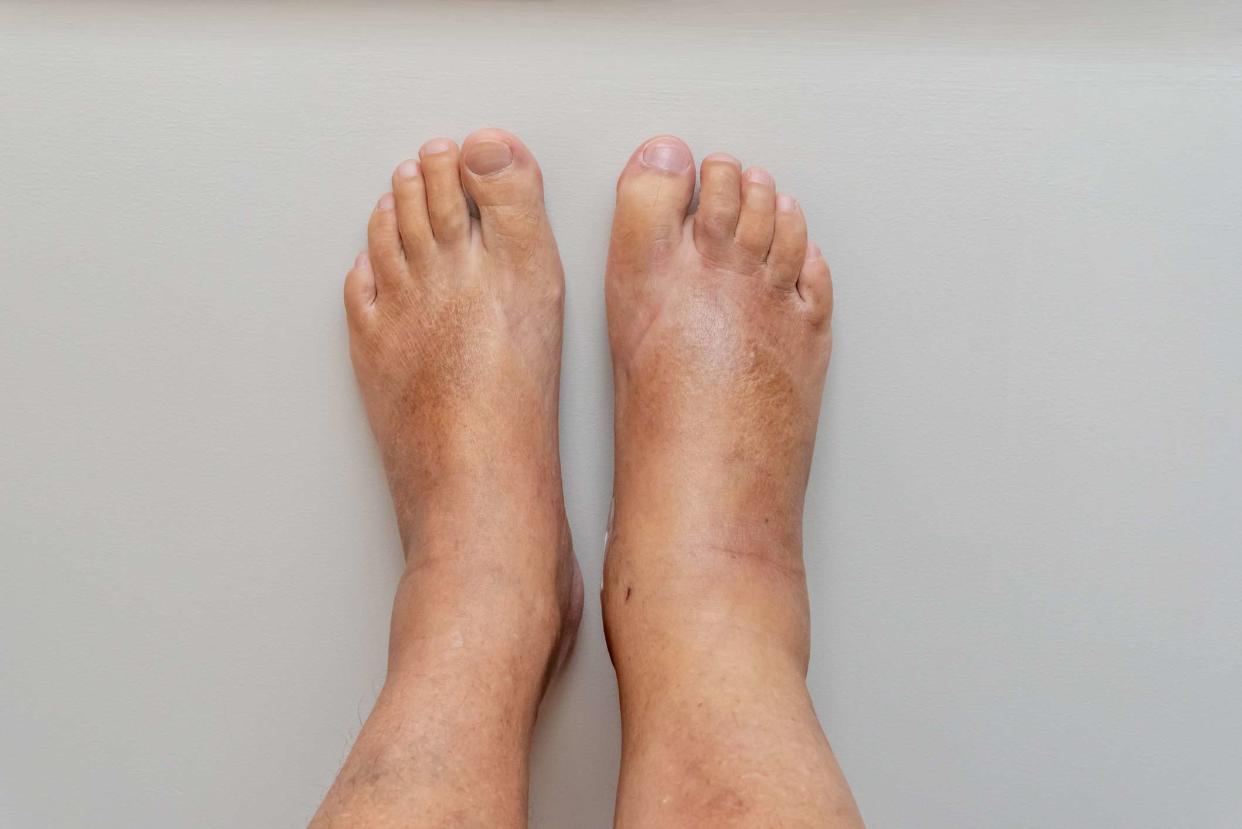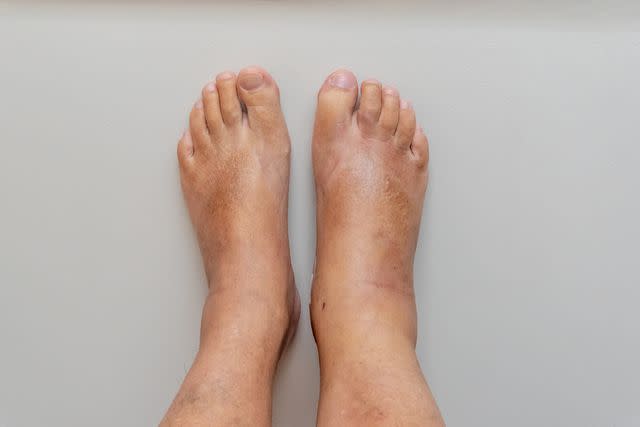7 Ways to Get Rid of Swollen Ankles Fast

Richard Jacyno / Getty Images
Medically reviewed by Oluseun Olufade, MD
Swelling in your ankles can have a variety of different causes, including injury, pregnancy, congestive heart failure, and arthritis. It will cause your ankles to look puffy and feel tight and stiff, which may restrict your ankle motion and ability to fit in your shoes.
Luckily, there are several things you can try to help alleviate related symptoms. Some of these strategies may help you minimize or get rid of swollen ankles faster than others, which include compression stockings, epsom salts, elevation, massage, and more.
This article will review home remedies for swollen feet and ankles, as well as when to see a healthcare provider about your symptoms.

Richard Jacyno / Getty Images
Compression Stockings
Wearing compression stockings applies continuous pressure to the legs, which can help improve circulation and decrease fluid accumulation in the ankles. Compression stockings are specifically recommended for managing swollen ankles that result from chronic venous insufficiency, with a compression intensity of 20 to 30 mm Hg for mild swelling and 30 to 40 mm Hg for severe swelling.
Edema is the clinical term for swelling that develops from excess fluid in the body’s tissues. Edema can occur in any part of the body but is very common in the feet and ankles, especially in older adults with compromised circulation. Exercise, including walking and ankle pumps, can help improve circulation and reduce swelling.
Compression stockings should not be worn by patients who have peripheral artery disease (PAD) due to the increased pressure. The stockings can further compress constricted arteries and compromise blood supply, which can cut off circulation and starve tissues of oxygen.
Epsom Salts
Magnesium deficiency is linked to increased inflammation throughout the body and often causes swelling. Epsom salts contain magnesium, which can be absorbed through the skin. Taking a bath or soaking your feet in a tub of water with Epsom salts may help decrease inflammation and swelling in the ankles by increasing magnesium levels.
Diet and Supplements
Reducing sodium (salt) intake can help balance your system and decrease swelling. If sodium intake is too high, your body will hold onto water to maintain an ideal ratio of sodium and water. This results in water retention that can produce abdominal bloating and swelling in the feet and ankles.
You can limit sodium intake by reducing the use of certain foods, especially:
Canned soups
Processed foods
Deli meats
Sausage
Dressings
Certain herbs, including parsley and dandelion, have a diuretic effect that helps to flush excess water from the body and can be taken as a supplement or as a form of tea. Drinks like coffee and tea that contain caffeine also have a diuretic effect.
Elevation
Elevating your feet utilizes gravity to assist in venous drainage of blood from your feet back to your heart. Because your feet and ankles are located below the level of your heart while sitting and standing for the majority of the day, fluid can accumulate in those areas if your circulation is compromised.
Veins require a lot of effort to pump blood back to the heart against gravity, so elevating the legs can help reduce the workload of your veins and allow blood to circulate back to the heart against less resistance.
Massage
When lymph vessels are damaged, excess fluid remains in tissues after blood is pumped to those areas, and has difficulty being removed from the body. Lymphatic drainage massage uses gentle manual pressure to help move lymph fluid from the body’s tissues into lymph vessels, which can help to relieve swelling.
Water
Without adequate hydration levels and the proper ratio of sodium and water, your body will store water rather than excrete it through sweat and urine, often resulting in excess fluid in the feet and ankles. To stay hydrated, aim to drink about half your body weight in ounces of water per day (about 75 ounces of water per day for a 150-pound person).
Urine that is concentrated and dark yellow in color is a sign of dehydration, while urine that is a clear yellow hue typically means you are hydrated.
Lifestyle Changes
If medication is causing your feet and ankles to swell, speak to your healthcare provider about lowering your dosage or changing the medication altogether. Calcium channel blockers used to treat high blood pressure, steroids to treat inflammatory conditions, certain antidepressants, and estrogen and testosterone treatment can cause swelling in the feet and ankles.
In addition to changing your medication, your healthcare provider may also prescribe you diuretic medication, commonly called water pills, such as Lasix (furosemide) and Diamox (acetazolamide) to help flush excess water from your body.
Limiting the amount of time you spend sitting and increasing exercise and physical activity will help alleviate feet and ankle swelling and improve circulation.
When to See a Healthcare Provider
If you have injured your feet, ankles, or legs, and experience significant pain and swelling, you should schedule a visit with your healthcare provider as soon as possible.
Pain, redness, and warmth in the feet and ankles in addition to swelling usually are signs of an infection and require immediate medical attention.
If that doesn't apply, but you have experienced swelling in your feet and ankles for more than one month, make an appointment with your healthcare provider.
They can examine you and evaluate you for underlying causes of swollen ankles, such as:
Injuries to your feet, ankles, or legs (it's possible there may be damage, though don't recall an incident)
Pregnancy which changes your body's overall fluid volume
Peripheral artery disease which damages your arteries
Chronic venous insufficiency which damages your veins
Congestive heart failure which limits the ability of your heart to pump blood efficiently
Chronic kidney disease which affects the ability of your kidneys to filter water and wastes from the body
Lymphedema, fluid buildup from damage to lymph nodes and lymph vessels
Cellulitis, a bacterial skin infection
Side effects of certain medications
Summary
Swelling in the ankles can result from a variety of different causes and can be managed at home through the use of compression stockings, elevation, monitoring sodium and water intake, diuretic supplements, lymphatic drainage massage, Epsom salts, and changing your medication.
If symptoms persist after trying home remedies for more than one month, you should see a medical professional to determine the underlying cause behind your ankle swelling.
Frequently Asked Questions
How long does it take to reduce swelling in the ankles?
The time frame for reducing swollen ankles varies depending on the underlying cause. Swelling can resolve in a few weeks with dietary and medication changes or can take up to several months for injuries and chronic conditions to improve.
What does it mean if my ankle swelling isn’t going away?
Swelling in the ankles that does not go away is often a sign of an underlying condition affecting the heart, blood vessels, musculoskeletal system, or lymphatic system.
What medications can cause swollen ankles?
Medications that can cause swollen ankles include calcium channel blockers to treat high blood pressure, steroids to treat inflammatory conditions, antidepressants, and estrogen and testosterone.
When should I be concerned about swollen ankles?
You should be concerned about swollen ankles if your swelling does not go away within a month, if your swelling worsens over time, if you have difficulty bearing weight through your feet, or if you exhibit any signs of infection.

